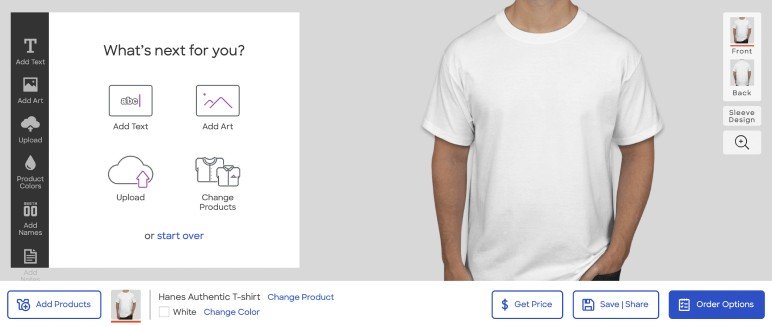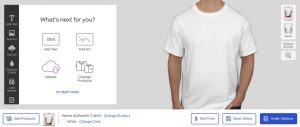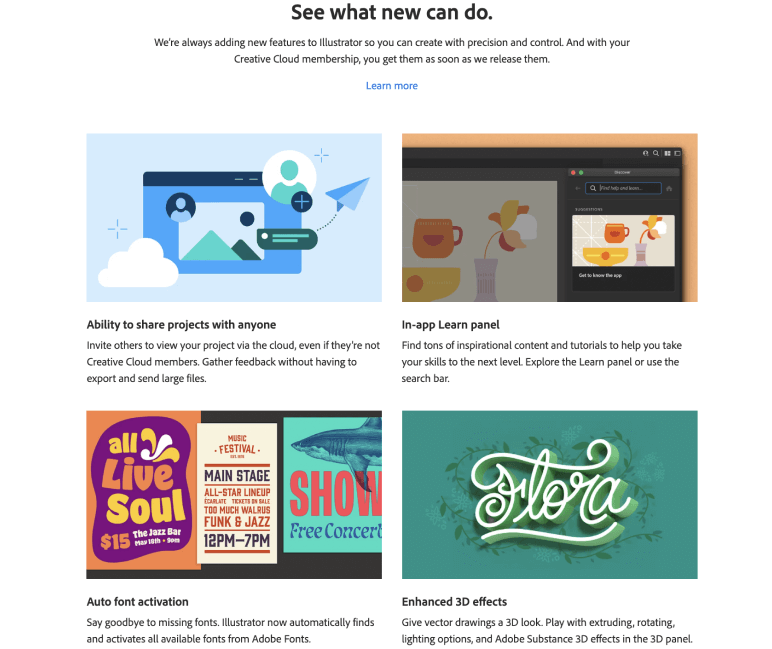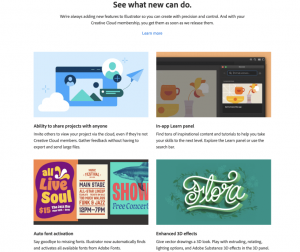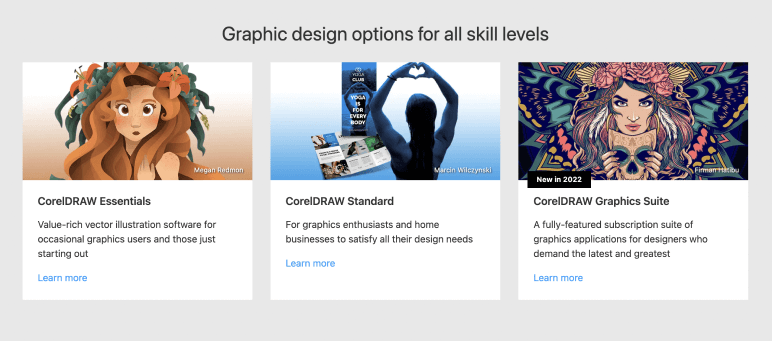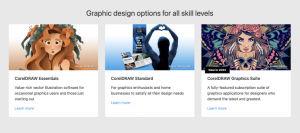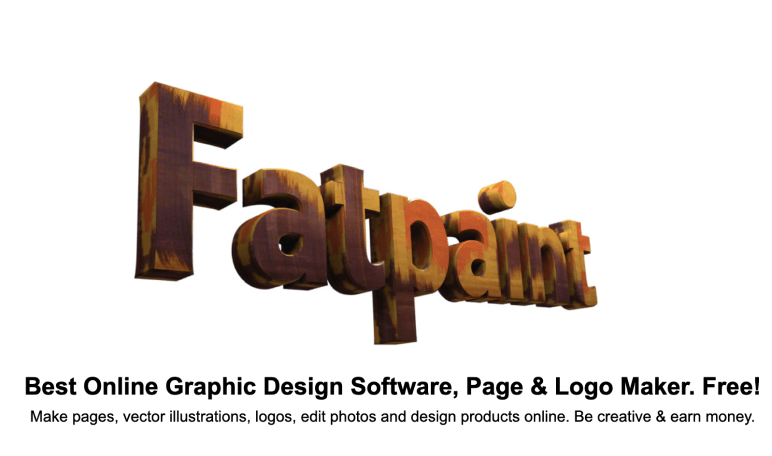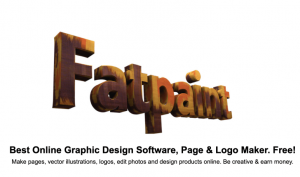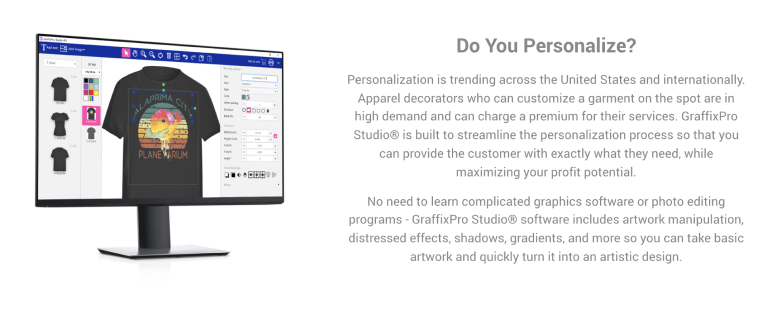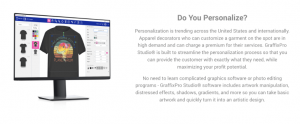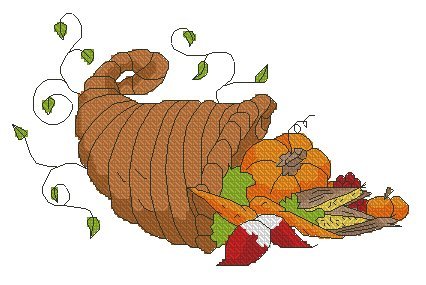Create a catalog of personalized t-shirts you’re proud to call your own – we’ll list the best design tools that get the job done. Alternatively, use this article to learn a useful skill and see the awesome designs you can come up up with.
The custom t-shirt industry has made leaps in online retail sales. Easy-to-edit mock-up templates have appeared on dozens of new websites, including Printify’s own T-shirt Mockup Generator. Creating your own custom t-shirts is easier than ever.
There are many graphic design software to choose from, so it might be tricky to decide which one is right for you. To make your decision easier, this article will look at:
- Essential features of graphic t-shirt design tools
- The top 12 t-shirt design software you should try
- Tips on creating a framework for your first designs
From high-gear subscription software to free browser tools – let’s make sure you make the right decision.
What is T-Shirt Design Software?
Have you ever been entranced by an art timelapse on Adobe Illustrator? Well, besides high subscription costs, you’re looking at an expensive graphics card and hours of late-night tutorials. This might be a daring challenge for some, but not every successful designer needs to go all-in right away.
Let’s erase some misconceptions.
Relying on an extensive toolkit is not a prerequisite for quality graphic design – you don’t need a background in the arts to produce brand-valued artwork. You can take advantage of more lightweight, easy-access tools that get you designing and publishing quickly and easily, provided you have the inspiration for something unique.
We’ve put the time to research multiple types of graphic design tools and the features you should know before choosing a particular one. Let’s look at some of the aspects where t-shirt design software provide essential utility:
- Vector graphics
The first vital distinction lies in using vector or raster graphics software when working with fabric printing. The standard practice is to start with vector graphics for smoothed lines and the ability to resize your artwork without degrading its quality. Once you have a high-resolution design, you can then rasterize the piece into a workable image file.
Raster graphics, or, in other words – pixel-base designs – are better for digital artwork and paper prints. If you want to prioratize designing t-shirts, most print providers expect a vector-based image for consistent quality.
Adobe Illustrator comes to mind – the industry staple for vector graphics – but it’s the very high-end option and takes a large piece of your budget before you get a chance to practice it. Willing to give it a go anyway? We admire the commitment but expect months of technical practice before you can realize your vision.
- Print methods
Good t-shirt design tools have to be able to provide compatible settings for different print methods. Printing techniques, similarly to graphics design, are multifaceted and unique, with strengths and weaknesses at play for any specific method.
Techniques such as Digital printing have made mapping out computer images to garments increadibly efficient, and the future of fabric printing is expected to become more and more optimized for large batches and high quality.
If you want to go in-depth and compare what different types of printing involve, and how to base your designs around them, check out these informative articles:
- Color modes
Working with optimal color modes is another crucial factor when starting your design and knowing what works best for your intended print prover and fabric type.
Take a look at the difference between RGB and CMYK color modes before putting ink to fabric. Your design software should have an option to compare, convert and create compatible image files for each mode. If not, an online image formatting tool can get the job done as well.
Top 12 Tools to Design Your T-Shirts
Now that you have a bit of background in t-shirt design, we can start looking at the tools fit for the job. Printify has applied its efforts to research, compare, and pick the best design software out there, outlining the pros and cons of each option.
From simple and flexible to intricate and extensive, choose the right software for you:
1. Custom Ink
With accessibility in mind, we start our list with a free, explicitly made-for-tee design software with a clear and straightforward interface.
Custom Ink offers thousands of images you can add and layer for a unique design. You can modify their free templates and stock images, filtered into different categories – animals, nature, transport, etc. – giving you a fast approach to creating awesome print designs. You may also upload your own images in seconds.
Once finished, their centralized platform will offer to order you a sample product.
In our consensus, Custom Ink’s library of fonts, number templates, and color options is best for bulk order deals for sporting events, brand attire, and gift bag goodies. A useful, albeit basic, tee designer master tool for quick production and graphic variety.
Pros:
- Free browser tool
- Easy interface with t-shirt design preview
- A vast library of graphics options
- Ability to add team names, slogans, including licensed logos
Cons:
- Clipart is preset – limited line editing
- Requires an existing design idea to start
- After creating a design, you must order shirts from the same website
2. Adobe Photoshop
Adobe Photoshop is by far the most recognized and extensive professional software at your disposal but as you consider this option, know that it comes with a steep learning curve and is one of the more expensive products on this list.
The Photoshop toolkit provides a world of customization for brush art, layering, blending, and creating image effects you’re likely not to find anywhere else. With a lot of flexibility comes a lot of practice, so you might have to consider going premium by applying to paid courses focused on more in-depth techniques.
Photoshop has more design versatility than other Adobe products but it doesn’t work with vector graphics so you’ll have some limitations in printing. Creating designs for DTG printing will be possible, but not screen printing or embroidery.
If you’re buying into the Adobe Creative Cloud service, you can get a discount on their full package, including Adobe Illustrator and Lightroom. The costs involved, of course, are the most significant downside.
Pros:
- Extensive toolkit and plugins for layering, large brush art, and image editing
- Trusted brand with high-quality tutorials and services
- No limitations for creating pixel artwork of any kind
Cons:
- Takes a long time and patience to master
- High recurring subscription costs
- No t-shirt design templates, assets, or images
- Does not work with vector graphics; limits printing options
3. GIMP
GIMP is Photoshop’s affordable alternative – a tech-savvy raster graphics design software that’s free and open-source. With a lot of the same features, the difference comes down to the age-old question: Android or Apple, Coke or Pepsi. GIMP is known for measuring up to Adobe services with community support, tutorials, and add-on features.
GIMP offers a lot of freedom for third-party plugins, although since many add-ons are freely available, you have to apply some healthy scrutiny to determine which are optimal and useful.
GIMP isn’t exclusively meant for t-shirt design, but you can easily find an online template and layer it under your graphic. In the end, the tools and features are respectable and have everything you need to start designing – change colors, add text, draw designs, work with blending modes, etc.
Pros:
- Free software that can match high-end graphics tools
- Available on all OS devices: Mac, Windows, Linux
- High community involvement and open-source features
Cons:
- Expect an initial steep learning curve
- Third-party plugins are not as reliable as paid software
- Difficulty working well with large-scale images and layers
- Lacks support for vector graphics, limits printing options
4. Adobe Illustrator
Adobe Illustrator is a full image editing software made for high-end commercial products, infographics, and brand logos – one of the more extensive tools we’ve looked at so far. This is the program you’ll see used by many professional designers.
When you’re looking to design t-shirts, Illustrator stands out in a couple of crucial ways: intricacy in measuring fine details, manipulating complex shapes, creating patterns, and finalizing high-resolution images.
Illustrator is the prime Adobe vector tool for a reason – you can easily size, shape, and manipulate your designs without compromising the quality and export an image file for any print method.
If you’re leaning more into paying for a versatile Adobe editing tool to use in multiple projects, we’d recommend Photoshop, but if you’re looking to become a commercial graphic designer, Illustrator is the better option.
Pros:
- Top-of-the-line vector editing software with unparalleled tools and features
- Great for shapes, patterns, and designs with a high print detail
- High community involvement, from minor issue fixes to full-scale tutorials
Cons:
- Takes a long time and patience to master
- High recurring subscription costs
- No t-shirt design templates, assets, or images
- Requires a capable hardware set-up to operate without issues
5. PlaceIt
PlaceIt is an in-browser t-shirt designer tool. It comes with a large stock of design templates and offers its own shirt orders. The main strength behind PlaceIt is its easy-to-use interface, quick setup, and vast library of quality vector clip art.
Say you have an awesome t-shirt idea and a clever design concept. PlaceIt is perfect for simple mock-ups that you can quickly realize without managing every pixel. Simply mix around its assets until you have a workable and unique design.
Premium templates may come with some costs, but their services are more than affordable – as little as $2.95 via subscription.
Pros:
- In-browser tool without any required installation
- Easy-to-use and comprehensive interface
- Library of premium design clip art
- Free to export designs anywhere
Cons:
- Access to some features is behind a paywall
- No mockup t-shirt templates to measure your design on
- No tools for image and design manipulation
6. CorelDRAW
CorelDRAW is a great mix of variety. From a design standpoint, this software is one of the more professional options. CorelDRAW works as a vector graphics design tool but has the flexibility for other format types. It prioratizes an easy-to-learn environment and is more beginner friendly than other high-end tools.
With the added benefits, expect a steeper cost but if you have the funds to invest, Corel Draw is well worth it. The website offers multiple unique subscription types depending on the extent of your use, from corelDRAW Essentials to the full corelDRAW Graphics Suite package.
Corel Draw prides itself as a great visual marketing software and manages to offer thousands of unique art assets, typefaces, and images as well as straghtforward editing tools for your own photos.
Pros:
- Great for creating detailed mock-ups
- Easy-to-learn with added tips and tutorials
- Library of premium design assets and images
- Access to extensive editing tools for any product type
Cons:
- High purchase and subscription costs compared to competitors
- The number of features makes some tools less developed than others
- The quality of file exports and imports has received some negative feedback
7. T-shirt Designer
T-shirt Designer lives up to its title. It’s a free custom t-shirt maker app for Windows 10, featuring great pre-made templates like round-collar, v-neck, and polo shirts.
With T-shirt Designer, you can upload images, draw with a selection of brushes, and work with all sides of the t-shirt. Create custom designs, shapes, and patterns with both back and front views. However, expect the design editing to be a bit limited in scope, as some interface options are not up to par with others on this list.
As a result of its features and scope, this free t-shirt maker is great for previews and creating a proof of concept design, but don’t expect to play with fine details and intricate measurements.
Pros:
- Multiple t-shirt templates
- Freeform brush editing and color options
- All-around front-and-back designing
Cons:
- Lacks useful editing features like saving, an undo button, and print formatting
- Real-time preview is not available – you must edit dimensions before placement
8. InkScape
InkScape is another more hands-on and flexible general graphics design tool preferred by many professional designers. Similar to GIMP, InkScape is lauded as a free high-end software alternative.
The software is designed specifically for vector editing, letting you export images in multiple sizes for high-quality designs. InkScape’s features include a huge range of dynamic font options, stylized effects, and measuring tools. Most importantly, InkScape will export vector images in a screen-printing-compatible format.
Pros:
- Suitable for multiple fabric printing methods
- Comprehensive design tools
- Easily converts pixel bitmaps to vector images
- Compatible with all major OS systems
Cons:
- Initial learning curve
- No t-shirt templates and previews
9. Fatpaint
Another in-browser software, Fatpaint is a free tool that features a huge library of almost a thousand typefaces, original templates, and hundresds of clip art images. You may also use it to create dynamic 3D modeled images to help you conceptualize your piece to the fullest extent.
Many templates are community-created, which lets you pick out unique concepts not found anywhere else. Fatpaint is a fairly simple design tool but has the ability to create original art and incorporate multiple assets.
While its website looks outdated and runs ads that clutter the interface, all its main functions remain free, including its huge trove of product templates.
Pros:
- Massive range of t-shirt designing templates
- All-in browser app with a quick start-up
- Total focus on creating product designs and images
Cons:
- Outdated website UI with longer load times
- Required sign-up, guest version might not load properly
- Ads and affiliate partnerships clutter the workspace
10. Design’N’Buy
Design’N’Buy has a straightforward, to-the-point interface with a competitive set of design features. It’s the preferred t-shirt design software for many online stores. Design’N’Buy is a smart shirt designer platform, offering eCommerce store integrations and publishing helpful articles to support you during multiple stages of development.
With this software, you can rely on 360° preview tools, resolution metrics, and controlled graphic editing that lets you layer and lock in specific elements. Their library includes a variety of fonts, clipart, and color options.
Pros:
- Full business integrations and product previews
- Website team offers a support network and helpful articles
- Integrated web-to-print technology
Cons:
- Design templates are not their sole focus
- The free demo excludes some site features
- Platform expects you to work within their service framework
11. Krita
We look at another powerful zero-cost graphics design alternative that you can use to place images and edit t-shirt designs. It’s an open-source digital-painting-focused software that excels at creative image editing.
Krita lets you apply your creative skills by experimenting with multiple customizable tools: brush control, color and blending modes, opacity, and effects controls. This is all coupled with easy beginner tutorials and an interface for creative and free photo editing.
One major highlight of Krita’s software is its ability to seamlessly create your own patterns that work well with a wrap-around design.
Pros:
- Highly customizable creative design tools
- Open-source and cross-platform compatible
- Great for tweaking ready-made photos and images
Cons:
- Large projects are prone to performance issues
- Expect a slight learning curve
- Lack of t-shirt templates and comprehensive typography tools
12. GraffixPro Studio
As a paid design software, GraffixPro is unique in the fact that its key features are specifically focused on creating personalized t-shirts for online retail, even if you’re a complete beginner.
GraffixPro has a library of unique designs and templates, fonts, and images. In their own words, it’s made to streamline creating personalized t-shirts and aims to maximize your profit potential. Conveniently, GraffixPro offers additional features like inventory management, a quote generator, and barcoding.
If you’re looking to manage t-shirt design without getting your hands dirty, GraffixPro makes the design process easy. You can still manipulate details and edit your art, but the focus is on making sure your designs can be published and sold without much effort.
Pros:
- Made for personalized t-shirt designs on a business level
- Create custom t-shirt designs quickly and easily
- Simple-to-use interface with little-to-no prior knowledge needed
Cons:
- Limits the use of more intricate graphics design tools
- Has a high purchase cost
- Less design control and fewer design assets than competitors
Make It Happen Today!
Creating a T-Shirt Design


Don’t limit your creative process to basic templates. When creating a design, you should start by knowing who it’s for and building a foundation for a solid and consistent design framework.
Here’s a basic layout of steps you should consider before starting on your own template:
- Define your audience
Customer likes, interests, and hobbies should be your main concern when planning to make sales. Art is subjective, but doing target demographic research will help you complement the styles and content audiences are already following.
Use social media apps like Facebook, Reddit, and Instagram to gauge potential trends and gain valuable info from the main source – potential customers.
- Layout your style, imagery, and placement
To establish your brand and create product awareness, practice consistency by outlining a style guide that you can stick to on multiple designs. This can involve sticking to specific typography, a consistent art style, complementary imagery, or centering your image on distinct t-shirt placement locations for a uniform composition.
Follow that up by mastering your t-shirt color palette. Stick to consistent and unique color swaths that compliment each other or draw upon appealing patterns. Lighter colors, for instance, work best with darker fabrics and vice-versa.
With colors in mind, remember that what you see on the screen might not be true to the finished product. Familiarize yourself with different printing techniques to gauge the setup you’ll need to focus on for the best quality.
- Create multiple designs
Not every design makes a polished cut. Don’t limit yourself to one trend or gimmick – experiment and follow up on a single design by creating more complex or simpler alternatives. Switch up the color palette and ensure all your assets are high quality.
For more detailed insights, check out these top tips to create better t-shirt designs and how to create a best-selling t-shirt design.
Best T-Shirt Design Templates
If you’re running a print-on-demand business, you’ll need a reliable way of developing design ideas consistently. This is where imageboard hosting sites can really help you out. With enough patience and curiosity on the internet, you can find access to preset templates that get you straight to the final product without a drawing tablet and years of mastering line art.
There are five basic template types that most dedicated software should be able to work with:
- Typography – text-based quotes and slogans with a crisp font design
- Photography – true-to-life photography such as landscape art and detailed portraits
- Graphic design – unique line-work, i.e., sketch art and stylized illustrations
- Branded design – promotional designs, logos, and established brand icons
- Abstract artwork – a mix of all or none; pattern designs and engaging color choices. Less narrative – more vibe.
Finding templates isn’t a difficult task. On our list, software like PlaceIt and Fatpaint have extensive community-created templates.
Google is your friend, in this case. You can explore top search results for t-shirt designs as a starter. For more established mood boards, you can explore sites like Pinterest – enter specific keywords like “retro logos” or “stencil art”. Another well-known option is Bonfire, where you can find a lot more customized template options. When looking for a muse, any user-created art is right at your fingertips.
Note: check if any images you find online are subject to copyright before replicating them in your designs. Check our guide on the dos and don’ts of using online assets legally.
To Sum Up…
We leave you off with a welcoming challenge to try these different tools at your own pace. We made this list with variety in mind to remain flexible with the level of complexity, the quantity of assets, interface difficulty, and, in simple terms, whether the software produces the results you’re expecting.
Let’s look back on your options:
- Custom Ink
- Adobe Photoshop
- GIMP
- Adobe Illustrator
- PlaceIt
- CorelDRAW
- Tshirt Designer
- InkScape
- FatPaint
- Design’n’Buy
- Krita
- GraffixPro studio
With the frequency and demand of custom t-shirts, this list is bound to remain incomplete, so always keep advancing and optimizing your toolset.
Finally, keep a set goal in mind. If you want these t-shirts printed and out in the real world, start your design with a quality resolution, appropriate printing and color choices, and t-shirt templates in mind. Keep a consistent, step-based approach to your design process to better establish your brand and cultivate a unique style.
Make It Happen Today!
The post Top 12 T-Shirt Design Software You Should Try in 2022 appeared first on Printify.


